It was neat getting another perspective of the fascinating Diamond Ring Sculpture made out of whiskey bottles outside the Guggenheim Bilbao Museum on our drive to Guernica, also known as Gernika for the local Basque population.
What a lovely drive we enjoyed to Guernika, famous to Basques as it's the site of the Gernikako Arbolo, the oak tree which marked the assembly point where the regional Basque leaders met through the ages to assert their people's freedom. Because the city was long the the symbolic heart of Basque symbolism, it was also a natural site for Franco and Hitler resulting in an infamous bombing raid that left the town in ruins.
That action was immortalized by Picasso in one of his most famous paintings, Guernica. Because of the ferocity of the bombing of Guernica and the powerful Picasso painting that documented the atrocities of war, the name 'Guernica' has also become synonymous with pacifism.
Out back was the Old Trunk that was planted around 1700. It was the oldest remains that still exist although there was documentary evidence of even older ones.
The (current) Tree of Guernica, planted in 2015 when it was fifteen years old, is said to be the direct successor of the tree under which the Assemblies were held for centuries. Basque leaders have met here in solidarity for centuries. In the Middle Ages, after Basque lands became part of Castile, Castilian kings came here to pledge respect to the old Basque laws.
Basques also featured prominently in the discovery and exploration of the New World, dealing on an equal footing with the European powers at the time, although always at the behest of the Church, the Crown of Castile or the King of France. They were conquistadors in Mexico and Peru, missionaries in southeast Asia and sailors in the Pacific. The list of Basques who made a name for themselves in the outside world included Juan Sebastian Elcano, the first man to sail around the world, and Catalina de Erauso, the nun lieutenant who fought, disguised as a man, in the Spanish army.
What is referred to as the Diaspora, or the dispersion of the Basques, began in the 19th century when thousands of Basques, in search of a better life, fled from poverty and wars or just looking for new experiences in other continents. Today, though these Basque emigrants and their descendants are inextricably tied to their new homelands, full integration didn't mean they still don't think of themselves as Basques, or they'd lost Euskara, the Basque language, Basque customs and traditions.
Kay: Did you notice there are several Basque communities in Idaho?
A number of guilds have cropped up to publicize and encourage consumption of certain products. Basque cuisine now owes its high reputation to a group of chefs who have reinvented traditional cooking in what is known as the new Basque cuisine, launching new dishes.
Several posts ago, I wrote about the Basque language but I discovered more about it at the Basque Country Museum. The Basques call the Basque lands Euskal Herria, which literally means 'the people of the Basque language.' Native Basque speakers call themselves euskaldunak or people who 'possess' the Basque language, thus distinguishing the inhabitants of a particular region solely by the language they speak.
It made perfect sense when I read that Basque dances were a regular feature of local fiestas and also the best expressions of Basque tradition because of the abundance and variety of dances, and the order and discipline of the steps involved which have basically remained unchanged.
Behind the museum was the People of Europe’s Park which was a nice place for a peaceful respite.
During the bombing, 31 tons of ordnance was dropped on the town of Guernica. The town center was razed to the ground with 271 buildings completely destroyed and others were partially affected. Incendiary bombs caused a fire that lasted for several days.
According to the Basque government, the attack claimed 1,654 lives. However, though many other sources claimed the actual number was far higher, the total number of fatalities was hard to determine. Part of the reason for the unknown tally was that Guernica was filled with refugees from other besieged towns during the Civil War. Another reason was the 60,000 cubic metric tons of rubble wasn't removed until the end of 1941.
During the intervening years, Franco's regime refused to admit any deaths and did his best to eliminate all the records kept of the attack by the Basque authorities, wiping even the memory of the victims off the pages of history. Still, research continues to calculate the number and the identities of those who lost their lives during the terrible tragedy.
From that unspeakable tragedy arose an effort by the people of Guernica to learn from what had happened and to highlight peace. This effort culminated in the reason for the existence of the Guernica Peace Museum. There was a collage of peaceful recollections in recent history - in Ireland, South Africa, Guatemala and Berlin.
It was gratifying to see that UNESCO awarded Guernica the 2002-2003 City for Peace award for its efforts to move forward from the tragedy and promote peace.
What a lovely drive we enjoyed to Guernika, famous to Basques as it's the site of the Gernikako Arbolo, the oak tree which marked the assembly point where the regional Basque leaders met through the ages to assert their people's freedom. Because the city was long the the symbolic heart of Basque symbolism, it was also a natural site for Franco and Hitler resulting in an infamous bombing raid that left the town in ruins.
That action was immortalized by Picasso in one of his most famous paintings, Guernica. Because of the ferocity of the bombing of Guernica and the powerful Picasso painting that documented the atrocities of war, the name 'Guernica' has also become synonymous with pacifism.
We stopped first at the Gernika Assembly House, the seat of the historical regional parliament. The meeting point for the Basque General Assembly during the Middle Ages was under the oak tree on a small hill above Guernica. I found it fascinating that the same, low tech tradition still continues to the present day.
The spectacular stained-glass ceiling in the main room was like a walking tour through Basque history. It was completed in 1985 and was crafted completely by hand. An elder statesman was shown standing under the oak tree by the tribune or colonnaded building. In his hand was a book called Lege Zarra or Old Law which listed the laws Basques lived by for centuries.
Below him were groups representing the three traditional Basque career groups: sailors and fishermen; miners and steelworkers; and farmers.
Small, square panels around the large window represented all the important towns in the region. Guernica was of course represented by the famous tree.
The triptych recalls a tragic event from 1878 when 255 Basque sailors lost their lives.
A display of 17th century hollow silver ballot sheets indicated they were used for voting at the meetings.
The Assembly Library:
The Chief Councillor is elected, the Charter Regulations that the regional government will enact, and the budget that is approved all take place in the Assembly Room. The space was conceived of as a Church Parliament for the Biscay region that could bring together political and religious functions at the same time.
Steven and I were so surprised we were able to wander around the de facto Parliament totally by ourselves. I can't imagine such a lack of security in many other such important places nowadays.
There was an impressive portrait gallery on the chamber's upper walls of 26 former Lords of Biscay.
The large paintings above the doors showed the swearing of allegiance to the Old Law.
When Basque independence came under fire in the 19th century, patriots rallied by singing a song about the tree. After the 1937 bombing of Guernica in which this tree's predecessor miraculously survived, hundreds of survivors sought refuge under its branches. Today, although official representatives are elected at the polls, the Basques choose their figurehead leader, the Lehendakari or First One, in this spot.
Just behind the tree and where the Assemblies have long met was the Santa Clara Convent. Through the railings, I could see a nun sweeping.
Just steps away was the Basque Country Museum which provided an interesting and informative overview of Basque culture and history.
There were models and styles of homes common to the Biscay region.
There was a display on cartographers and navigational instruments that were developed because of the often warring regional factions among the seven territories in the Basque region.
The map showed the seven regions of Basque Country.
One of the most interesting displays was about Basques around the world. Because the Basque homeland was a place where both goods and travelers passed through between the Iberian Peninsula and the rest of continental Europe, the Basque people, clearly motivated by their proximity to the sea, moved with great freedom to all corners of the world. Classical writings recorded the presence of Basques in different parts of the Roman Empire. Trade and fishing took many as merchants to northern Europe and as cod fishermen and whale hunters off the coast of Iceland.
What is referred to as the Diaspora, or the dispersion of the Basques, began in the 19th century when thousands of Basques, in search of a better life, fled from poverty and wars or just looking for new experiences in other continents. Today, though these Basque emigrants and their descendants are inextricably tied to their new homelands, full integration didn't mean they still don't think of themselves as Basques, or they'd lost Euskara, the Basque language, Basque customs and traditions.
Kay: Did you notice there are several Basque communities in Idaho?
From the information provided about Basque cuisine, I learned that a whole culture has grown up around groups of friends getting together to cook and eat a wide range of traditional dishes accompanied by wine, cider or the young white wine known as txakoli grown in coastal areas.
Several posts ago, I wrote about the Basque language but I discovered more about it at the Basque Country Museum. The Basques call the Basque lands Euskal Herria, which literally means 'the people of the Basque language.' Native Basque speakers call themselves euskaldunak or people who 'possess' the Basque language, thus distinguishing the inhabitants of a particular region solely by the language they speak.
The language doesn't belong to any of the world's other language families. It's the oldest in Europe and survived the arrival and domination of Latin. The museum information indicated the varieties or dialects of Basque are spoken by more than a million people. Largely oral in nature, the first texts written in Basque were little more than words on Roman gravestones or medieval documents. However, after the 16th century, literary works began to appear, accompanied by a growing number of language and grammatical studies.
I was glad that Steven and I took the time to see the exhibits at the museum as they gave us a far greater insight and appreciation into what it meant to be Basque.
Behind the museum was the People of Europe’s Park which was a nice place for a peaceful respite.
Across the street from the museum was Santa Maria Church. You'll see more about it in a bit.
From the church, we walked down to the city's large square where we saw the City Hall and the Guernica Peace Museum, respectively.
A view of Town Hall across the square from the Peace Museum:
We began our tour of the museum in a small darkened room, made to look like a small living room in an apartment with a few photos on the wall, a table and large mirror. We listened to the voice of a local woman, Begona, describe her typical life in Guernica in the 1930s. Monday, April 26th, 1937, began like any other day, she said, thinking about the coal she needed to buy for the stove, the games she loved to play with her neighbors. She listened to the nearby church bells, thinking a wedding was taking place.
There had been so many alarms in Guernica (because of the Spanish Civil War), she stated, that she had been taking less and less notice of them after a while. She tried to concentrate on thinking of the beautiful things that happened in her life: her life as a child, her marriage, dances and the theater. She recounted the bells of Santa Maria Church where she went for daily Mass at 7 am gave her enthusiasm to face each day.
It was Market Day and she was about to go shopping when she could hear planes arriving, the sounds of bombs falling and see the destruction beside her home. Then sound and visual effects cued, behind what we thought had been a mirror, of the German and Italian planes arriving, bombs falling, and people screaming. It was so realistic it felt like we were also experiencing that horrific day as Begona was.
The first plane arrived shortly after 4 pm and dropped a number of bombs. A few minutes later, the first wave of planes arrived. This was the beginning of the systematic bombing of Guernica which continued for over three hours. People running through the streets or along the green hillsides were strafed with machine gun fire. The destruction of Guernica was perpetrated by the German and Italian air forces acting on the commands of Franco's rebel army. The military tactics were so severe that Guernica has gone down in history as the first experiment in total war.
Franco's troops entered Guernica three days after the bombing with support from Italians and Germans. Many of the occupying forces who were staying at the Santa Maria Church and other areas around the city, forced locals to clean these places which had been thereby profaned, an apparent humiliation that was particularly humiliating.
Why did the bombings happen in Guernica? I read that reportedly, Hitler wanted an opportunity to try out his new saturation-bombing attack strategy. Spanish dictator Francisco Franco, who was fed up with the independence-minded Basques, offered up their historic capital as a candidate for the experiment. Oddly though, a small munitions factory that supplied anti-Franco forces with pistols wasn't hit, nor was a key bridge. Historians believe most of the targets were far from strategic. The question that has haunted so many people is why attack so mercilessly during the daytime, on market day, when innocent casualties would be maximized.
During the intervening years, Franco's regime refused to admit any deaths and did his best to eliminate all the records kept of the attack by the Basque authorities, wiping even the memory of the victims off the pages of history. Still, research continues to calculate the number and the identities of those who lost their lives during the terrible tragedy.
Before and after photos of the currently named Guernica Peace Museum:
While we were at the museum, we saw high school groups learning about what had happened in their town so long ago and then discussing about what peace was and the tools used to being about peace. The latter ranged from a respect for human rights, firm dialogue, listening to others, searching for a common ground, mediating to unite the wishes of both parties to admitting our mistakes, to standing up for justice and thinking positively.
I watched a moving video about William Kelly, an American-born artist now living in Australia, who has mentored a generation of people to become both humanists and artists through the impact of his work. He has received awards on three continents for his work.
As part of our upcoming trip to New Zealand and a small part of Australia in March, a friend and I'd already planned to go to the State Library of Victoria in Melbourne. But now finding out about Kelly's massive project, Peace or War, in the Library gives us even more incentive to visit and see his work.
It was impossible not to feel shaken by what had happened on that terrible Market Day in April of 1937 but seeing the expressions of hope by other artists were also inspiring.
The commemoration of what took place at Guernica was an attempt to comprehend what happened and the mistakes of the past. Only then may we begin to improve our present and work toward our future.
Hearing word about the attack in Paris, Spanish painter Pablo Picasso, who had been commissioned to paint a mural for the 1937 World's Fair, was devastated at hearing about the bombing. Inspired, he painted what many consider to be the greatest anti-war art ever, called Guernica. Above the museum was a tile representation of the work. We were lucky enough to see the powerful original later in Madrid.I hope you'll like seeing the compelling original in an upcoming post.
We took the back roads back to Bilbao, relishing in the small towns, the farms and homes of this part of the Basque region.
After learning about the terrible events in Guernica, it seemed only fitting to stop briefly at the huge municipal cemetery outside of Bilbao. It was raining or was that God's tears, I wondered.
The cemetery's chapel:
On the way into Bilbao, Steven stopped for a few minutes so I could watch a hovercraft, suspended by wires from the Bizcaia Bridge, travel from one side to the other of the Nerion River. If we'd had more time and better weather, that would have been a fun thing to do, but we had neither so I was content with watching.
Next post: A stroll along Bilbao's riverfront and Burgos Cathedral.
Posted on December 21st, 2018, from Amsterdam, the day before we fly home after over four and a half wonderfully exciting months on the road that started in August in Paris and then took us through Armenia and Georgia, some of the spectacular 'Stan countries' in Central Asia, much of Spain and then a taste of Portugal before finally coming here to Amsterdam.
I have many posts yet to write about our travels beyond Bilbao so I hope you will continue to follow our travels in the weeks and months ahead. I thank you for taking the time to read my lengthy posts, and especially for commenting on some of them. Steven and I wish each of you a wonderful Christmas and holiday season filled with joy and happiness, spent with family and friends. We hope the New Year brings you good health and also a chance to travel and explore more of our wonderful world.























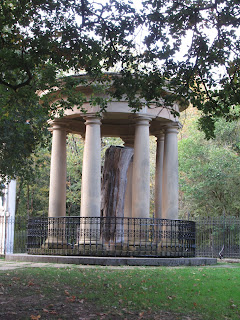



























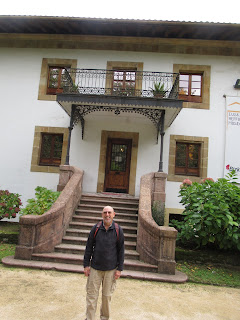















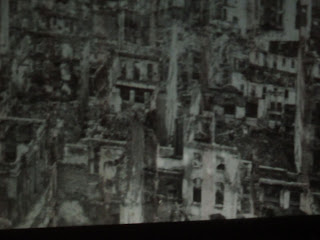




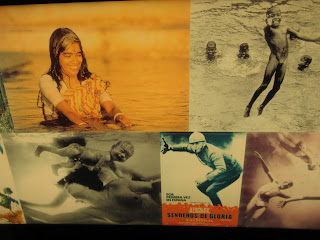












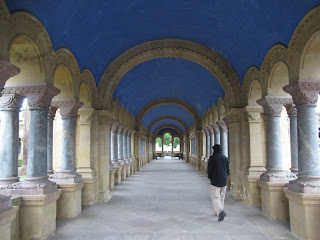











Loved the stained glass in the Gernika Assembly House. It showed the pride in the ethnic group. I also wish Annie and Steven a wondrous Holiday Season. I look forward to reading the remaining blogs of their wonderful adventure. Janina K
ReplyDeleteJanina,
ReplyDeleteThe stained glass in Guernica's Assembly House was one of the largest and most spectacular I can recall seeing outside a place of worship. Glad to see you also appreciated the stories it told of the vibrant Basque heritage.